Note: As part of Boston Partners in Education’s 50th anniversary celebration, we will be releasing a weekly installment of stories from our “50 Years, 50 Stories” series, beginning with the following selection. Check back weekly to read additional stories throughout our anniversary year.
 Though Boston Partners in Education is an independent non-profit, many of our years were spent as one of a number of notable school volunteer organizations, collectively known as the National School Volunteer Program, and later on, the National Association of Partners in Education. While we have always operated and designed our programs to address local needs, the national organization offered a way to share ideas and best practices to make each program more effective. It also created a means of support for superintendents keen on creating school volunteer programs in their communities.
Though Boston Partners in Education is an independent non-profit, many of our years were spent as one of a number of notable school volunteer organizations, collectively known as the National School Volunteer Program, and later on, the National Association of Partners in Education. While we have always operated and designed our programs to address local needs, the national organization offered a way to share ideas and best practices to make each program more effective. It also created a means of support for superintendents keen on creating school volunteer programs in their communities.
Our organization was started in 1965 through a grant from the Ford Foundation, secured by the Public Education Association, who had used a previous grant to create a school volunteer program in New York City. This second grant allowed them to found school volunteer programs in 20 major cities across the United States, including Boston. A similar organization, the Council for Public Schools, took the grant to establish the program, with the intent that it became independent as soon as possible.
In the 1970’s, after School Volunteers for Boston became incorporated, they formed a national program along with the other School Volunteer programs throughout the country. SVB, later Boston Partners in Education, were often leaders in the organization. It’s notable that two of our consecutive executive directors, Isabelle Besecker and Betsy Nelson, both took director positions and were influential in NSVP programming.
A national report entitled, Volunteers in Public Schools released in 1990, claims that while nationwide volunteer participation fell 4% between 1981-1985, participation in school volunteers had actually increased by 4% during the same time period.
School Volunteer activities nationwide reflected what we were doing locally. The report states, “the committee found a great variety of services provided by volunteers, including: Tutoring students in need of special help with such skills as reading, writing, and mathematics; listening attentively to children who “need a special friend”; working to develop English-language skills in children who are immigrants to the United States; acting as mentors and enhancing students’ appreciation of arts and literature through lectures and organizing and operating computer labs…The committee also observed programs in which volunteers serve as surrogate grandparents in intergenerational programs that try to overcome stereotypical separations between young and old.”
The intergenerational program, specifically, was a program pioneered by School Volunteers for Boston, demonstrating again our leadership within the organization. This was illustrated in other ways, too. School Volunteers for Boston became independent more quickly than other organizations did, because they succeeded in forming strong and lasting partnerships with the business community. It was a mandate of the organization to connect the business community with the school community, which has produced many fruitful endeavors. That tradition has continued throughout the decades, shown best in today’s Power Lunch and Big Cheese Reads initiatives.
Today, the national program no longer exists, having folded sometime in the late nineties. However, many of the school volunteer programs and partners in education organizations still exist throughout the country. Our notable strengths of responding to the requests of the schools and maintaining our status as conduit between support from business leaders and the education community have been a part of preserving our organization and its important position with Boston Public Schools.
